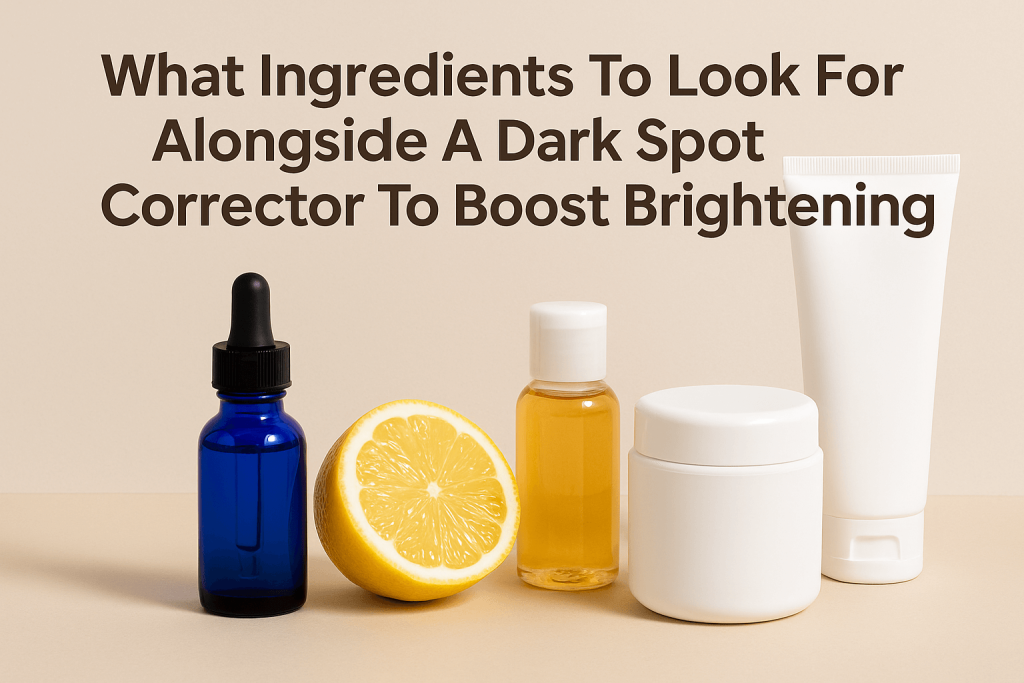You’ve bought the serum. You’ve cleared a spot on your bathroom shelf. You’ve even whispered sweet nothings to your dark spot corrector like, “Do your thing, baby.”
Three weeks later?
Still waiting.
Let’s be clear: the problem isn’t necessarily the product. It’s the lone-wolf approach. Because when it comes to fading dark spots, your corrector is just one player. The real glow-up happens when you build a team.

Vitamin C: The Brightening Hype That Actually Delivers
This isn’t just skincare influencer fluff—Vitamin C really works.
It brightens, protects, and fights off environmental stress like a caffeinated bodyguard for your face. When paired with your dark spot corrector, it helps even out tone and slows down new pigmentation before it shows up.
Just be picky:
- Look for L-ascorbic acid (10–20% range)
- Keep it in opaque packaging (sunlight = product murder)
- Use it in the morning, always with SPF
Because what’s the point of erasing spots if you’re going to let the sun draw them back in Sharpie?
Niacinamide: Chill. Reliable. Gets the Job Done.
Niacinamide isn’t flashy, but it’s that best friend who always answers your 2 a.m. texts.
It reduces inflammation, improves barrier function, fades discoloration, and works with almost everything. Including your dark spot corrector.
Use it daily. Twice if your skin agrees.
Your face will thank you with a nice, even glow.
Alpha Arbutin: The Underrated Overachiever
Quietly fading spots while causing zero drama? Alpha arbutin is the introvert of brightening ingredients.
It gently blocks melanin production without irritation—perfect for sensitive skin or anyone who’s already using more aggressive treatments (looking at you, retinol fans).
It won’t change your life in a week, but give it time and it will make a difference.
AHAs: Out With the Old Skin
No, you don’t need to scrub your face raw. That’s not exfoliation—that’s bullying.
What you want are alpha hydroxy acids like glycolic or lactic acid. These dissolve dead skin cells so your dark spot corrector can reach the pigment it’s meant to treat.
Used 1–2 times a week, they:
- Speed up cell turnover
- Improve product absorption
- Give your skin that smooth, lit-from-within look
Overdo it, though, and you’ll trigger irritation. And guess what that leads to? Yep—more pigmentation. Don’t be that person.
Licorice Root Extract: The Plant-Based Peacekeeper
Fun fact: licorice root is one of the most well-studied natural brighteners in dermatology.
It calms the skin, reduces redness, and gently lightens dark spots—making it perfect for layering with actives that tend to bring the drama (hi, acids and retinoids).
Bonus: It smells faintly sweet and makes you feel like your routine is somehow “cleaner.” Even if your sink says otherwise.
Retinoids: The Long Game Powerhouse
Everyone talks about retinoids for wrinkles, but their pigment-fading abilities? Seriously underrated.
They:
- Increase skin cell turnover
- Boost collagen
- Help fade post-inflammatory hyperpigmentation
Yes, they come with a learning curve. Start slow. Moisturize like it’s your job. But long-term? They’re worth every flaky week you endure.
Final Thought: One Product Doesn’t Do It All (Sorry)
Your dark spot corrector might be powerful—but it’s not a miracle worker. Boost its potential by pairing it with the right supporting cast: antioxidants, exfoliants, skin soothers, and melanin regulators.
And while you’re at it? Wear the damn sunscreen. Because if you’re not protecting your progress, you’re just doing expensive skincare laps.